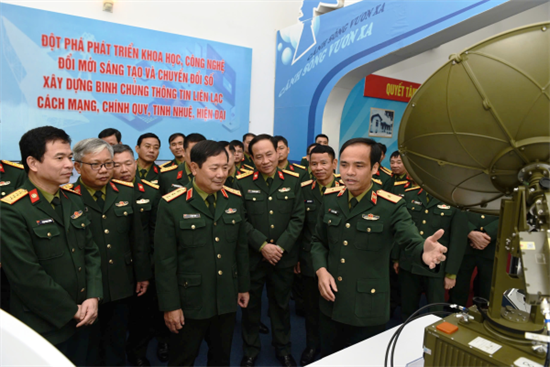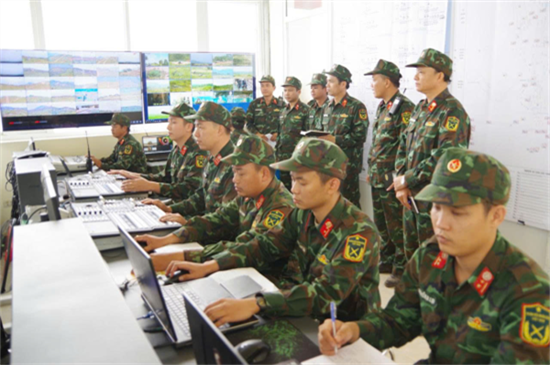Making Signal Corps capable of meeting Fatherland protection requirements in the new situation
Being proud of its 80-year tradition of construction, combat, combat service, and maturity, the Signal Corps continues taking synchronised measures to modernise itself, ensuring seamless communications for leadership, direction, command, and operation, meeting the requirements of military and defence tasks and Fatherland protection in the new situation.
Right after the foundation of the Democratic Republic of Vietnam, in response to the urgent need to ensure communications for the Party Central Committee and the General Command to uniformly direct and command the armed forces to prevent and thwart enemies’ plots and artifices against our nascent revolutionary government, on 7 September 1945, Military Communications Department was founded. Only after 2 days later (9 September 1945), cadres and soldiers of the Department successfully established a radio network and a special communications network. That became a historic milestone - the Traditional Day of the Signal Corps.
 |
| Corps Commanders introduces a transmission line for digital transformation within the Ministry of National Defence |
In the past 80 years of construction, combat, combat service, and maturity, generations of troops of the Signal Corps have remained united, ingenious, valorous, and creative, overcoming countless hardships and sacrifice to ensure “timely, accurate, secret, safe” communications. Many cadres and soldiers of the Corps showed no fear of sacrificing their lives for guaranteeing “seamless communications”, going down in history as a shining symbol of revolutionary heroism, providing great support for our Vietnam People’s Army (VPA) to achieve glorious victories in the cause of national liberation, construction, and protection as well as in international missions. In recent years, the Corps has formulated many breakthrough measures, giving sound specialised advice to the Central Military Commission (CMC) and the Ministry of National Defence (MND), directly commanding and directing the modernisation of the Military Signal Force and the Corps itself. The military communications system has been developed strongly in terms of size and mode with modern technology and diverse services at all strategic, operational, and tactical levels; the quality of ensuring communications has been raised to opportunely serve training, exercises, combat readiness, natural disaster response, search and rescue, national political events, and defence diplomacy. With its brilliant achievements, the Signal Corps was given the title of Hero of the People’s Armed Forces, Gold Star Order, Ho Chi Minh Order, 2 Independence Orders (First Class and Third Class), 3 Military Merit Orders (First Class, Second Class, and Third Class), 9 Feat-of-Arms Orders (First Class, Second Class, and Third Class), and First-Class Fatherland Protection Order by our State; the Kingdom of Cambodia also conferred upon the Corps Angkor Order; 69 collectives and 37 individuals from the Corps were given the title of Hero of the People’s Armed Forces.
Currently, the cause of VPA building and Fatherland protection has new developments, setting the Corps very high goals and new requirements, together with many challenges and issues to be addressed. The robust development of science and technology, particularly the application of Artificial Intelligence (AI) and the processing of big data have been making breakthroughs in the field of military communications. In fact, communications play a crucial role in facilitating leadership and command and lay a technological foundation for command automation and control over hi-tech weapons, such as unmanned aerial vehicle (UAV), unmanned surface vehicle (USV), missile, guided artillery shell, as well as for electronic warfare, cyber warfare, administrative reform, digital transformation, and the building of E-government within the VPA. Fully aware of its role, functions, and assigned tasks, the Signal Corps continues realising the guidelines on building a modern Corps, with a focus on implementing “the Strategy to develop military communications system in the period of 2021 - 2030, with a vision towards 2045”, via several main measures as follows.
 |
| Communications support for an exercise |
First, proactively, actively performing staff work and raising the effectiveness of state management of military communications. The Corps attaches special importance to improving the quality of researching, forecasting, and assessing tasks and new issues as the basis for giving advice to the CMC, MND, and competent offices on effectively executing “the Strategy to develop military communications system in the period of 2021 - 2030, with a vision towards 2045”, adjusting and supplementing goals, tasks, road map, and steps in the implementation of the Strategy in each period in a timely, proper manner. In the medium term, in order to facilitate the work of leadership, direction, and command after force adjustments aimed at the building of an “adept, compact, strong”, modern VPA and the re-organisation of local military agencies within the two-tier local government system, the Corps proactively reviews communications support documents and focuses on providing communications support and equipment for offices and units; priority is given to units tasked with manoeuvre and combat readiness, newly-founded forces, units equipped with modern weaponry, and the task of leading, directing, and commanding local military and defence work. Besides, it continues giving advice on designing and completing legal documents on managing and commanding the military communications system; it works with telecoms service providers to increase the solidity of the military communications system and the industrial mobilisation capacity to ensure communications in all situations.
Second, continuing to make a breakthrough in raising the quality of education and training. Grasping the CMC’s Resolution 1659-NQ/QUTW, dated 20 December 2022, on raising the quality of training in the period of 2023 - 2030 and beyond, the entire Corps concentrates on achieving a breakthrough in improving the quality of combat training, enabling troops to master specialised skills and tactics, making troops “expert in traditional communications, highly skilled in mobile communications, and adept in hi-tech communications equipment”, meeting the criteria for “elite mobile detachment”. While holding refresher courses to improve cadres’ operational staff work and capabilities in grasping, managing, and operating communications networks, the Corps intensifies the specialised training of its technical staff as the core force in receiving, using, and repairing new-generation communications equipment. It regularly supplements and completes projects to provide communications for natural disaster mitigation and search and rescue across the country. Besides, it continues building its two schools in a revolutionary, regular, modernised, standardised, well-integrated fashion towards smart school model, ensuring that “the quality of schools is the combat readiness capacity of units”. At the same time, it stimulates scientific research, developing the art of ensuring communications in strategic operations and new forms of warfare, making the art of communications support appropriate to modern weaponry and advances in the 4th industrial revolution.
Third, building a modernised military communications system. The Corps develops a synchronised, modern, IP-based fixed-line network, taking transmission networks as the backbone, considering data transmission networks as the foundation for developing military communications services with ultra-large capacity and ultra-broad bandwidth, providing extensive connectivity across the entire Military in line with the requirements of command automation and the building of E-government within the VPA. It upgrades strategic lines, transforming regional network technology into broadband IP technology for optical transmission networks, expanding and upgrading military data transmission networks with segment routing technology, completing technological transformation, expanding the scope of support for the softswitch-based exchange networks. It organises centralised system and regional backup management, ensuring flexible connectivity with civilian telecoms networks on a multi-service network platform, combining modern equipment and technology with experiences in communications support in all situations, in VPA building and Fatherland protection, in diplomatic activities, and in support for our forces participating in United Nations peacekeeping operations. It makes investment in a mobile communications system in sync with the fixed-line network at all strategic, operational, and tactical levels. In the short term, it effectively executes the project to “increase mobile communications system potential” and acquire modern military hardware, such as automated VSAT stations, multifunctional switchboard devices, and hand-held communications equipment. At the same time, it completes and submits projects to the MND on deploying a new-generation troposcatter communications network, low-orbit satellite systems, UVAs for TV communications, and 5G mobile network for the field of military communications. As for operation centres, their activities are based on digital data and technology to ensure uniformity and synchronicity in managing and commanding the military communications system; coordination between forces is closely maintained to facilitate the process of exploitation and development and opportunely deal with communications incidents.
Fourth, well performing technical support work. Grasping and strictly implementing the CMC’s Resolution 1656-NQ/QUTW, dated 20 December 2022, on leading technical work towards 2030 and beyond, the Corps focuses on perfecting methods and modes of technical support in accordance with the development of communications equipment, ensuring centralised operation and repair combined with modular and equipment replacement. At the same time, it makes use of advanced technologies in technical management, adopting automation of manufacture, repair, and management of equipment and technical force, building and upgrading repair facilities into smart factories, repair workshops, and depots with automated management, reception, and distribution. Besides, it proactively collaborates with domestic businesses to manufacture communications equipment at tactical and operational levels, striving to master the manufacturing of equipment, materials, and spare parts as well as software and operating systems for technical support and system development. It continues maintaining mobile technical support teams to prevent “white zones” in technical support work.
Promoting their 80-year heroic tradition, generations of cadres and soldiers of the Signal Corps continue devoting efforts to achieving new feats of arms, building a modern military communications system, excellently accomplishing all missions assigned by the Party, State, and people.
Maj. Gen. VU VIET HOANG
Commander of the Signal Corps